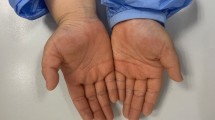Abstract
This study was conducted to investigate the acute dermal and ocular irritation potential of rice bran supercritical CO2 extract (RB-SCE) and a 0.5% RB-SCE essence product in rabbits and guinea pigs. No abnormal clinical signs attributable to RB-SCE were detected. In the dermal irritation test, erythema, eschar, and edema formation was observed at 24 h of RB-SCE treatment, and the skin returned to normal after 72 h. The dermal primary irritation index (PII) of RB-SCE was 2.71; thus it was classified as a moderate irritant. In the ocular irritation test, there were no clinical signs related to the application of the RB-SCE; thus it was classified as a non-irritant according to the Draize scoring system. In a skin sensitivity test in rabbits, no abnormal clinical signs attributable to RB-SCE essence were observed and the PII was 0 because there was no evidence of erythema, eschar, or edema. In the guinea pig skin sensitivity test, no abnormal body weight changes or increased mortality was detected. Sensitization to the RB-SCE essence was 0%; thus it was classified as a very weak irritant.
Similar content being viewed by others
References
Pourali, O. in Production of valuable materials from rice bran biomass using subcritical water (Osaka Prefecture University, Japan, 2010).
Lee, J. W. et al. Beneficial effect of the unsaponifiable matter from rice bran on oxidative stress in vitro compared with α-tocopherol. J. Sci. Food Agric. 85, 493–498 (2005).
Prabhakar, J. V. & Venkatesh, K. V. L. A simple chemical method for stabilization of rice bran. J. Am. Oil Chem. Soc. 63, 644–646 (1986).
Manosroi, A. et al. Biological activities of the rice bran extract and physical characteristics of its entrapment in niosomes by supercritical carbon dioxide fluid. J. Supercrit. Fluid. 54, 137–144 (2010).
Saunders, R. M. The properties of rice bran as a foodstuff. Cereal Foods World 35, 632, 634–636 (1990).
Luh, B. S. in Rice: Production and Utilization (AVI Publishing Company, Inc., Connecticut, 1980).
Abdul-Hamid, A. & Luan, Y. S. Functional properties of dietary fibre prepared from defatted rice bran. Food Chem. 68, 15–19 (2000).
Xu, Z., Hua, N. & Godber, J. S. Antioxidant activity of tocopherols, tocotrienols, and γ-oryzanol components from rice bran against cholesterol oxidation accelerated by 2,2′-azobis(2-methylpropionamidine) dihydrochloride. J. Agric. Food Chem. 49, 2077–2081 (2001).
Reddy, K. V., Maheswaraiah, A. & Naidu, K. A. Rice bran oil and n-3 fatty acid-rich garden cress (Lepidium sativum) seed oil attenuate murine model of ulcerative colitis. Int. J. Colorectal. Dis. 29, 267–269 (2014).
Zavoshy, R., Noroozi, M. & Jahanihashemi, H. Effect of low calorie diet with rice bran oil on cardiovascular risk factors in hyperlipidemic patients. J. Res. Med. Sci. 17, 626–631 (2012).
Dhara, R., Dhar, P. & Ghosh, M. Dietary effects of pure and diacylglycerol-rich rice bran oil on growth pattern and lipid profile of rats. J. Oleo. Sci. 61, 369–375 (2012).
Pezzoli, G. et al. n-hexane induces parkinsonism in rodents. Brain Res. 531, 355–357 (1990).
Karakaya, A. et al. Some immunological parameters in workers occupationally exposed to n-hexane. Hum. Exp. Toxicol. 15, 56–58 (1996).
Yeddes, N. et al. Supercritical SC-CO2 and soxhlet n-hexane extract of Tunisian opuntiaficusindica seeds and fatty acids analysis. J. Lipids 2012, 1–6 (2012).
Sahena, F. et al. Application of supercritical CO2 in lipid extraction- a review. J. Food Eng. 95, 240–253 (2009).
Choi, J. S. et al. In vivo hair growth-promoting effect of rice bran extract prepared by supercritical carbon dioxide fluid. Biol. Pharm. Bull. 37, 44–53 (2014).
Ruksiriwanich, W. et al. 5α-Reductase type 1 inhibition of Oryza sativa bran extract prepared by supercritical carbon dioxide fluid. J. Supercritic. Fluid. 59, 61–71 (2011).
Draize, J. H., Woodard, G. & Calvery, H. O. Methods for the study of irritation and toxicity of substances applied topically to the skin and mucous membranes. J. Pharmacol. Exp. Ther. 82, 377–390 (1944).
Cariello, A. J. et al. Assessment of ocular surface toxicity after topical instillation of nitric oxide donors. Arq. Bras. Oftalmol. 76, 38–41 (2013).
Simeonova, R. & Danchev, N. Assessment of surgical sutures POLYMED® by intracutaneous irritation test in rabbits. Interdiscip. Toxicol. 6, 99–102 (2013).
Djerrou, Z. et al. Irritantcy potential and subacute dermal toxicity study of Pistacia lentiscus fatty oil as a topical traditional remedy. Afr. J. Tradit. Complement. Altern. Med. 10, 480–489 (2013).
Lee, H. S. et al. Fermenting red ginseng enhances its safety and efficacy as a novel skin care anti-aging ingredient: In vitro and animal study. J. Med. Food 15, 1015–1023 (2012).
Padol, A. R. et al. Safety evaluation of silk protein film (a novel wound healing agent) in terms of acute dermal toxicity, acute dermal irritation and skin sensitization. Toxicol. Int. 18, 17–21 (2011).
Choi, J. S. et al. Cytotoxicity and single-dose oral toxicity testing for rice bran supercritical CO2 extract. Toxicol. Environ. Health Sci. 5, 215–220 (2013).
Author information
Authors and Affiliations
Corresponding author
Rights and permissions
About this article
Cite this article
Choi, JS., Moon, JN., Moon, WS. et al. Acute dermal and ocular irritation testing of rice bran supercritical CO2 extract (RB-SCE) and 0.5% RB-SCE essence product. Toxicol. Environ. Health Sci. 7, 65–72 (2015). https://doi.org/10.1007/s13530-015-0222-4
Received:
Revised:
Accepted:
Published:
Issue Date:
DOI: https://doi.org/10.1007/s13530-015-0222-4




